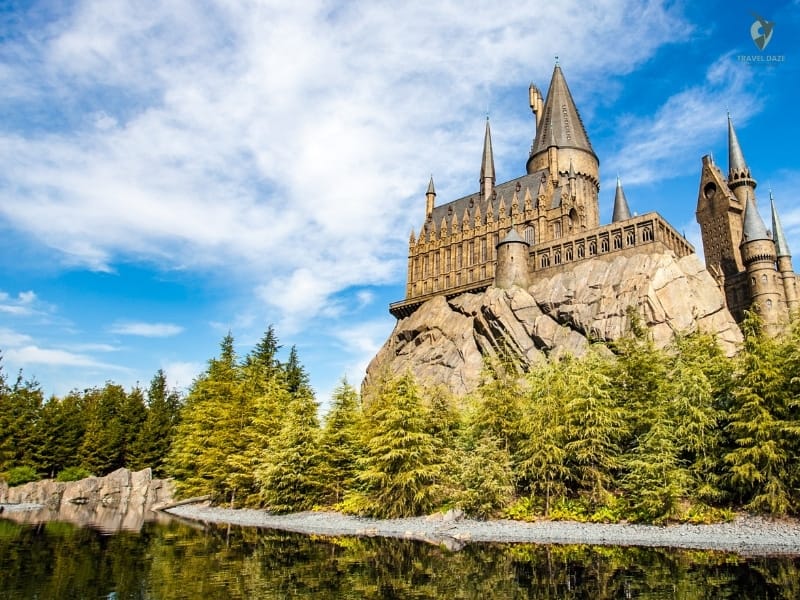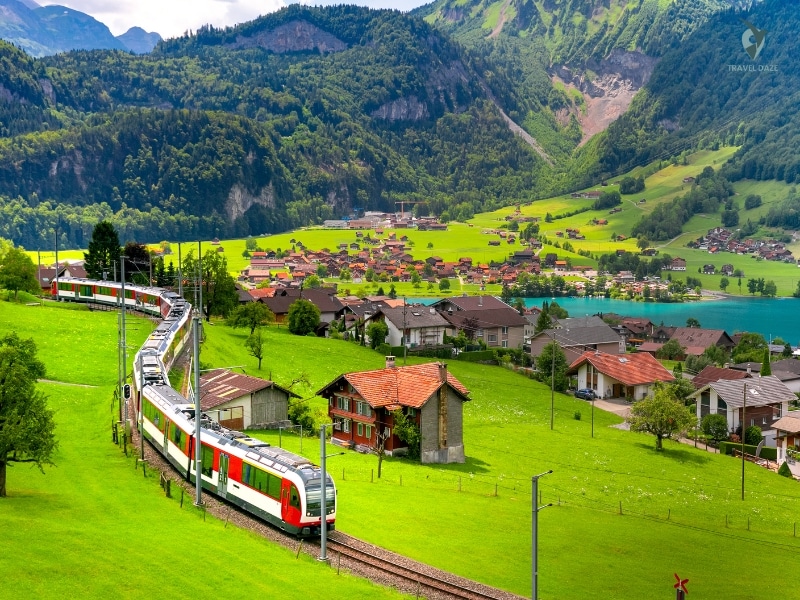As a solo traveller, I began my journey to discover Japan’s most stunning castles. I found a captivating mix of history, architecture, and natural beauty. Each site, from the 16th-century buildings that have lasted through the years to the new ones built today, shares its own special story.
Table of Contents
ToggleAs I walked through these historic landmarks, I admired their strong designs and seasonal beauty. The cherry blossoms surrounded the stone walls, making a beautiful view. The JR Pass made it simple to travel from one place to another, discovering hidden treasures along the journey.
One of the most interesting features I found was the whispering floors, which are meant to warn about intruders. The black crow facades were another highlight, bringing a sense of mystery to the architecture. These details made every visit memorable.
Main Points
- Japan has 12 original castles from the feudal period.
- New buildings exist alongside real structures from the 16th century.
- The beauty of the seasons, such as cherry blossoms, makes the experience even better.
- The JR Pass makes it easy and quick to visit different castles.
- Special features include whispering floors and black crow façades.
Japan’s castles will leave you in awe.
Nothing can truly ready you for the impressive beauty of Japan’s historic fortresses. As I got closer to the huge stone walls, I felt small in comparison to their size. The moats mirrored the sky, enhancing the visual effect. These were not just buildings; they were symbols of power.

I was most amazed by how they combined military strength with creativity. Pointed angles for protection met elegant, curved roofs. Some Japanese castles still have original wooden beams inside, worn smooth over the centuries. Some buildings, made of concrete, reflect the past while remaining strong today.
I will always remember walking through a feudal-era keep. The air had the scent of old wood, and sunlight came through the window grilles. Nearby, the rebuilt areas seemed refined but didn’t carry the same hint of history.
These landmarks influenced the development of Japan’s cities. Samurai used to live in circles around the castle, with their rank deciding how close they were. Now, those same areas are lively with cafes and shops, but the original layouts are still there.
Long ago, only nobles and fighters were allowed inside. Now, everyone can discover. The change from being exclusive to being accessible makes these sites even more remarkable. As I stood on the watchtower, I saw how much Japan has progressed while still respecting its traditions.
The Interesting Story of Japan’s Castles
Travelling through Japan’s old fortresses showed us the deep history and strength of the past. These structures changed from mountain forts in the 15th century to powerful centres on the plains. Over time, they turned into symbols of feudal power.
In the Sengoku period, which lasted from 1467 to 1615, warlords constructed these fortresses to protect themselves. Oda Nobunaga’s efforts to unify changed their construction. Castles changed from strong, mountain styles to impressive, flatland structures.
Wars and time have made their impact. After 1868, many were lost, and World War II destroyed 80% of them. Today, just 12 original keeps still exist, serving as reminders of Japan’s history.
From Fortresses to Feudal Symbols
As I walked through Himeji Castle, I touched the original wooden beams and felt the history in them. At the same time, modern replicas are impressive, but they don’t have that real link to history.
As I walked through the defensive circles of “honmaru” (main enclosure) and “ninomaru” (secondary enclosure), I pictured samurai planning their strategies inside these walls. These designs were useful and meaningful, showing the social structure of feudal Japan.
How Wars and Time Influenced Their Legacy
Many castles were destroyed during WWII, showing how vulnerable they were. Still, their survival shows how important they are. These landmarks are not just old objects—they connect us to a past time.
As I stood on top of a watchtower, I admired how these buildings have lasted through the years. They are not only remnants of the past; they are vibrant parts of Japan’s cultural heritage.
Must-See Castles in Japan
Each fortress has a story to share—just wait until you see these amazing structures. I put together this list focussing on genuine quality, easy access, and unique features. From famous giants recognised by UNESCO to hidden gems, each one amazed me.

Himeji’s white castle shines like a heron soaring in the sky. The black crow façade of Matsumoto gives off an air of mystery. Hikone, while small, has a timeless quality. Reconstructed sites, such as the tall keep in Osaka, contain original artefacts that tell stories of the samurai era.
Why Are These Landmarks So Important to See?
- Himeji’s perfect preservation has earned it worldwide recognition as a UNESCO gem.
- Hikone offers beautiful hilltop views that match its peaceful atmosphere, away from the crowds.
- Experience the beauty of Hirosaki in spring, where the moats are filled with pink blossoms.
What do I like the most? The moon-viewing turret at Matsumoto during sunset. With fewer tourists, you can enjoy the feudal atmosphere more fully. In contrast, Osaka’s park is filled with cherry blossoms, but it’s best to arrive early to avoid the crowds.
Tip: In autumn, Kumamoto’s stone walls become a vibrant display of colours. If you love history, Nijo’s floors still make soft sounds like nightingales, just as they did many years ago.
Himeji Castle: The White Heron of Hyogo
Entering Himeji Castle felt like walking into a work of art that has stood the test of time. The white plaster walls shone in the sunlight, giving it the name “White Heron”. This famous landmark, finished in 1609, is a UNESCO World Heritage site and one of Japan’s best-preserved fortresses.
A UNESCO World Heritage Site since 1993.
Himeji Castle, designated as a UNESCO World Heritage site in 1993, showcases Japan’s remarkable architectural skill. The 83 buildings display the beauty and practicality of designs from the feudal era. As I walked through the complex, I admired how each detail contributed to both its beauty and protection.
Inside the Castle: Secrets of the Keep
While exploring the main keep, I found hidden arrow slots and stone-dropping hatches. These features were created to confuse and discourage intruders. The keep has six stories filled with narrow staircases and rooms, each showing a part of history. It offers an interesting look at the clever thinkers from history.
How to Visit Without the Crowds
I got there right when it opened on a weekday to steer clear of the crowds. The 15-minute walk from Himeji Station along Otemae-Dori was calm and beautiful. To capture the perfect photo, visit Koko-en Garden, where the castle’s reflection sparkles in the water. A helpful tip: the sunset makes the white walls shine, giving them a beautiful glow.
Osaka Castle: A Place of History and Cherry Blossoms
As I stood in front of Osaka Castle, I was amazed by how it combined history with the beauty of nature. The original structure was built in 1585, but it was destroyed and then rebuilt in 1931. Today, it is a symbol of strength, located in a park with 600 cherry trees.
The Tower That Lasted for Hundreds of Years
The tower of Osaka Castle is an impressive feat of engineering. The outside keeps its historic charm, while the inside features a modern museum with holograms and interactive displays. As I walked through, I noticed the difference between the old walls and the modern displays.
A key moment was finding the original stones in the foundation. These worn blocks share tales of fights and rebuilding. It creates a real link to history that makes the experience richer.
Magic of Spring in the Castle Park
Spring turns the park into a wave of pink blossoms. The cherry blossoms create a magical feeling, especially around Nishinomaru Garden. This place is ideal for hanami, the traditional cherry blossom viewing. I was captivated by the beauty of the flowers, their soft petals dancing in the wind.

I suggest going in the evening when the lights are on for a more peaceful experience. The gentle lights highlight the delicate beauty of the flowers, creating a truly enchanting view. Weekends can be busy, so think about different places to view or try visiting early in the morning.
- The museum’s interior is modern, while the outside remains steeped in history.
- The best place for hanami is Nishinomaru Garden, where you can enjoy beautiful views.
- The evening lights are a must-see during cherry blossom season.
- To avoid the weekend crowds, come early or look for quieter places.
Osaka Castle is not just a landmark; it’s a trip back in time, made even more beautiful by the changing seasons around it. This site has something memorable for everyone, whether you love history or nature.
Matsumoto Castle: The Black Crow of Nagano
The outline of Matsumoto Castle set against the Japanese Alps caught my attention. The black lacquer walls, known as “Karasu-jo” (Crow Castle), stood out against the snowy mountain tops. This castle tower, built in 1594, is one of the few original ones left in Japan from the 16th century.
The shiny dark surface looked almost unreal when seen up close. The six-storey tower stood tall above the moat, its reflection adding to the scene’s intensity. The unique wooden interior had the scent of old cypress. Each beam and nail showed the skill of traditional craftsmanship.
The Importance of Visiting the Moon-Viewing Turret
The third floor confused me—windows were positioned in a way that would compromise security. Later, I found out they were included for the moon-viewing turret of the castle tower. Samurai used to come here to enjoy the beauty of the autumn harvest moon. Today, a yearly festival brings back the tradition with lanterns and tea ceremonies.
Going up the steep stairs needed care, but the ground floor had easy-to-reach exhibits. The castle displayed armour replicas and matchlock guns, highlighting its military history. The Alps created a beautiful backdrop outside, perfect for taking pictures.
Enjoy Local Flavours During Your Visit
The castle is only 15 minutes from the station, making it a great option for a day trip. I decided to visit the nearby Daio Wasabi Farm for something different. Riding a bike through green wasabi fields felt very different from the history of feudal times – yet both honoured Nagano’s heritage.
By 5 PM, the crowds had lessened, allowing the moat to reflect the calm beauty of Matsumoto Castle. As the light dimmed, the “Black Crow” appeared to close its wings—a watchful guardian over the mountains.
Hirosaki Castle: Aomori’s Cherry Blossom Wonderland
As I stepped onto the grounds of Hirosaki Castle, pink petals danced around me, creating a beautiful springtime scene. This Aomori Prefecture landmark features 2,600 cherry trees, turning its Edo-era walls into a beautiful floral display every May. In contrast to the earlier blooms in southern Japan, spring arrives here a bit later.
Strolling along the moats during cherry blossom season
Daytime visits shine with bright pink canopies stretching over the stone walls. Sunset brings real magic—pathways shine with paper lanterns until 9 PM. I rented a rowboat for $15 an hour and paddled through the beautiful, flower-filled moats. The castle’s reflection in the water beautifully mirrored the flowers.
- During the golden hour, the west moat captures the brightest sunset colours.
- You have to try the apple pie at the castle cafe; it features Aomori’s famous fruit.
- Weekday mornings provide peaceful opportunities for great photos.
The Lightning Strike That Altered Its Destiny
People in the area still talk about the 1627 lightning strike that set the original keep on fire. According to legend, a lightning-struck samurai stole some hidden gold from the fire. The three-tier tower we see today was rebuilt in 1810 and stands strong like a phoenix rising from the ashes.
As I walked around, I discovered plaques that indicated where the old building used to be. Nearby, cherry trees that have been grafted—some over 300 years old—bloom boldly, their roots intertwined with history. It’s a touching reminder that beauty can still exist, even in the face of disasters.
Kumamoto Castle: The Phoenix Rises After the Earthquake
As I walked through Kumamoto Castle, I was amazed by its strength and rich history. This national treasure suffered major damage in the 2016 earthquakes, with 60% of its structures impacted. It remains a symbol of strength, with reconstruction planned to finish by 2028.
Restoring a National Treasure
While I looked around, the difference between the damaged parts and the restored areas was very noticeable. Old stone walls were broken in places, next to carefully fixed sections. The old ishi-otoshi stone-dropping methods, which were once used for protection, are now being brought back during the rebuilding process. The castle’s lasting legacy is truly remarkable.
Volunteers have been essential in the rebuilding efforts. Their stories of commitment and enthusiasm made my visit feel more personal. A volunteer explained how they carefully matched stones to keep the castle’s authenticity intact. It’s uplifting to witness a community unite to bring back this national treasure.
- Visible damage includes crumbled walls and cracked foundations that remind visitors of the earthquakes in 2016.
- Repaired areas highlight traditional building methods.
- Volunteer stories: Listen to personal experiences of the community’s commitment to rebuilding.
- Interactive AR displays: See the castle’s beauty before the earthquake using augmented reality.
After exploring, I went to nearby ramen shops to enjoy Kumamoto’s famous tonkotsu ramen. The rich, creamy broth was a wonderful way to finish the day. The interactive AR displays at the castle provide a closer look at its past splendour. This is a place everyone should visit when they come to this famous site.
Nijo Castle: The Floors That Whisper in Kyoto
Walking into Nijo Castle was like stepping into a part of history that is still alive. This world heritage site, built in 1603, is a stunning example of castle architecture, combining beauty with smart design. As soon as I walked on the “uguisu-bari” (nightingale floors), the gentle chirping sounds filled the halls—a smart way to warn of intruders.
The difference between the luxurious shogun chambers and the simple guard rooms was very noticeable. The shogun’s rooms were decorated with detailed gold leaf and painted screens, while the guards’ rooms were plain and practical. As I walked through these spaces, I could almost hear the soft whispers of samurai planning their next move.
To find a hidden gem, visit the secret viewing spot in Ninomaru Garden. The garden’s carefully placed rocks and ponds beautifully outline the castle’s walls. It’s a calm getaway from the busy tourist spots.
It’s a great idea to visit the nearby Kyoto Imperial Palace during your trip. Both sites provide a look into Japan’s feudal history, but Nijo stands out with its special features, such as the whispering floors, making it a memorable experience. Keep in mind that photography is not allowed in the golden chambers, so take in the details with your eyes.
Nijo Castle is not just a landmark; it’s an experience that takes you back in time. From the chirping floors to the calm gardens, every detail shares a story of strength, creativity, and perseverance.
Hikone Castle: A Secret Treasure by the Lake
Not many travellers visit Hikone Castle, but those who do find a beautifully preserved gem. This fortress on the hill was built over 20 years (from 1603 to 1622) and is one of the few original castle keeps left in Japan. It’s a 15-minute walk from the station, and it feels like time has stood still.
Wide Views and a Sense of Freedom
Reaching the top floor gave me a beautiful view of Lake Biwa, the largest freshwater lake in Japan. The view was definitely worth the climb up the stairs. Cherry trees lined the stone walls, and with no crowds around, it was easy to picture feudal lords looking over their land.
- During WWII, Hikone was fortunate to avoid destruction because of its remote location, unlike many other landmarks.
- I found it funny when a staff member in costume invited me to a pretend sword duel, and we even took some pictures!
- For a great experience, consider combining your visit with a Lake Biwa cruise to enjoy sunset views of the castle from the water.
There were few signs in English, but volunteers with iPads and friendly smiles helped by translating interesting historical facts. Their enthusiasm transformed dry facts into lively tales. As I walked away, I looked back at Hikone Castle, its reflection sparkling in the water of the moat. Some secrets are too great to keep to ourselves.
How to Explore Japan’s Castles Like an Expert
Visiting Japan’s historic sites showed me how crucial it is to plan and be on time. If you’re visiting for the first time or have travelled many times before, these tips will help you enjoy your trip to the fullest. Here are some tips for exploring without the hassle of crowds and transport issues.
Ideal Times to Steer Clear of Tourist Crowds
When visiting popular sites, timing is crucial. I found it best to steer clear of Golden Week, which is from late April to early May, as that’s when many domestic travellers crowd the city centres. Try to choose weekdays or early mornings. Autumn is great—it’s cooler and there are fewer people, making it a wonderful time to explore.
Summer can be very hot, so make sure to prepare for it. Stay hydrated and rest in shaded spots. If you visit during busy times, get there when it opens to see the sights before it gets crowded.
How to Use Your JR Pass for Simple Travel
The JR Pass makes visiting castles much easier. Many landmarks can be reached using JR lines, which makes it a budget-friendly choice. It’s a good idea to pick either regional or nationwide passes depending on your travel plans. Regional passes are ideal for specific trips, whereas nationwide passes provide more flexibility.
Here’s a helpful tip: use luggage lockers at big train stations to keep your travel light. Walking is often needed at many castles, so bringing less can make the visit more enjoyable. Make sure to get a castle stamp collection book—it’s a great way to keep track of your visits.
- Golden Week: Steer clear of this busy travel time for a more enjoyable experience.
- JR Pass: Select either regional or nationwide options depending on your travel plans.
- Luggage lockers: Keep your bags safe at main stations for easy access.
- Collect unique stamps at each location for a special keepsake.
These tips will help you explore Japan’s historic landmarks effortlessly. No matter if you’re admiring 16th-century architecture or enjoying the scenery, these tips will help make your experience enjoyable.
Are you prepared to explore the tales of Japan’s castles?
As I walked through these historic sites, I felt a strong link to Japan’s history. As I touched the old walls, I could nearly hear the whispers of samurai and lords who once walked here. This serves as a strong reminder of the history that formed this nation.
To enhance your experience, plan your visit around local festivals. Picture cherry blossoms surrounding a castle in spring or lanterns glowing over moats in autumn. These moments make the stories of these landmarks come alive.
Before you leave, please check the reconstruction statuses. Some places, such as Kumamoto, are still undergoing restoration, but their strength makes them even more appealing. What do I like the most? Himeji at sunset—its white walls shine like a heron soaring through the sky.
Are you ready to explore? Get a JR Pass for easy travel between these famous locations. It’s your chance to discover the stories of Japan’s castles, step by step.
FAQ
What makes Himeji Castle unique?
Himeji Castle is a UNESCO World Heritage Site famous for its beautiful white walls and graceful design. It is often referred to as the “White Heron” due to its elegant look. The main keep has withstood wars and natural disasters, making it a real historical treasure.
Is it possible to visit Osaka Castle during the cherry blossom season?
Of course! Osaka Castle is a great place to see cherry blossoms in the spring. The castle park turns into a sea of pink, making a magical atmosphere. It’s a wonderful mix of history and natural beauty.
Matsumoto Castle is known as the “Black Crow” because of its dark exterior, which resembles the colour of a crow’s feathers.
Matsumoto Castle got its nickname due to its impressive black exterior. The difference between its dark walls and the nearby landscape creates a unique and somewhat mysterious feeling. Be sure to check out the Moon-Viewing Turret to see a piece of history.
When is the ideal time to visit Hirosaki Castle?
Hirosaki Castle is a place you should visit during sakura season, which typically occurs from late April to early May. The moats and gardens are full of cherry blossoms, creating a perfect spot for photographers and nature enthusiasts.
What is the status of Kumamoto Castle’s recovery from the earthquake?
Kumamoto Castle was heavily damaged in the 2016 earthquake, but work to restore it is still in progress. Some areas of the castle welcome visitors, and the ongoing rebuilding shows its strength and cultural significance.
What makes the floors of Nijo Castle special?
Nijo Castle is known for its “nightingale floors”, which make a chirping sound when someone walks on them. This was a security feature to notify guards about intruders. It’s a captivating mix of buildings and history that you can’t find anywhere else.
What makes Hikone Castle worth a visit?
Hikone Castle is a beautiful place that offers a calm and timeless atmosphere. It is one of the rare original castles in Japan that has not undergone significant reconstruction. The hilltop spot provides beautiful views of Lake Biwa, creating a peaceful getaway.
What can I do to steer clear of crowds when I visit these places?
The best times to avoid crowds are early mornings or weekdays. Visiting during quieter times, such as late autumn or winter, can provide a more peaceful experience while still appreciating the beauty of these landmarks.






